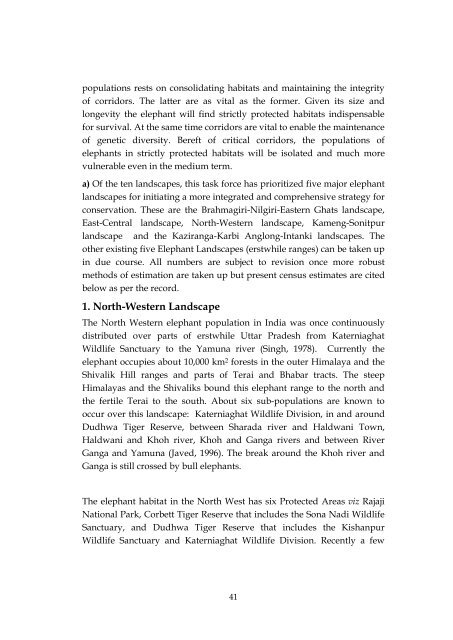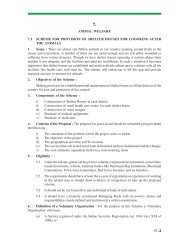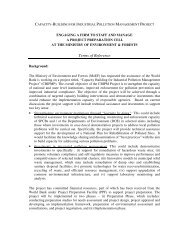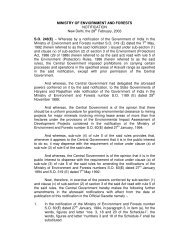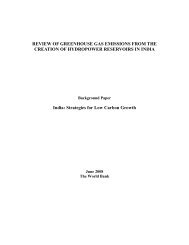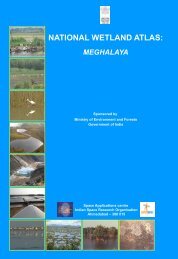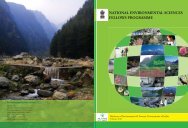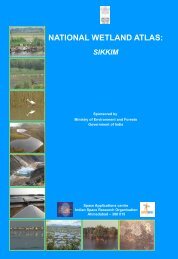Securing the Future for Elephants in India - Ministry of Environment ...
Securing the Future for Elephants in India - Ministry of Environment ...
Securing the Future for Elephants in India - Ministry of Environment ...
Create successful ePaper yourself
Turn your PDF publications into a flip-book with our unique Google optimized e-Paper software.
populations rests on consolidat<strong>in</strong>g habitats and ma<strong>in</strong>ta<strong>in</strong><strong>in</strong>g <strong>the</strong> <strong>in</strong>tegrity<br />
<strong>of</strong> corridors. The latter are as vital as <strong>the</strong> <strong>for</strong>mer. Given its size and<br />
longevity <strong>the</strong> elephant will f<strong>in</strong>d strictly protected habitats <strong>in</strong>dispensable<br />
<strong>for</strong> survival. At <strong>the</strong> same time corridors are vital to enable <strong>the</strong> ma<strong>in</strong>tenance<br />
<strong>of</strong> genetic diversity. Bereft <strong>of</strong> critical corridors, <strong>the</strong> populations <strong>of</strong><br />
elephants <strong>in</strong> strictly protected habitats will be isolated and much more<br />
vulnerable even <strong>in</strong> <strong>the</strong> medium term.<br />
a) Of <strong>the</strong> ten landscapes, this task <strong>for</strong>ce has prioritized five major elephant<br />
landscapes <strong>for</strong> <strong>in</strong>itiat<strong>in</strong>g a more <strong>in</strong>tegrated and comprehensive strategy <strong>for</strong><br />
conservation. These are <strong>the</strong> Brahmagiri-Nilgiri-Eastern Ghats landscape,<br />
East-Central landscape, North-Western landscape, Kameng-Sonitpur<br />
landscape and <strong>the</strong> Kaziranga-Karbi Anglong-Intanki landscapes. The<br />
o<strong>the</strong>r exist<strong>in</strong>g five Elephant Landscapes (erstwhile ranges) can be taken up<br />
<strong>in</strong> due course. All numbers are subject to revision once more robust<br />
methods <strong>of</strong> estimation are taken up but present census estimates are cited<br />
below as per <strong>the</strong> record.<br />
1. North-Western Landscape<br />
The North Western elephant population <strong>in</strong> <strong>India</strong> was once cont<strong>in</strong>uously<br />
distributed over parts <strong>of</strong> erstwhile Uttar Pradesh from Katerniaghat<br />
Wildlife Sanctuary to <strong>the</strong> Yamuna river (S<strong>in</strong>gh, 1978). Currently <strong>the</strong><br />
elephant occupies about 10,000 km 2 <strong>for</strong>ests <strong>in</strong> <strong>the</strong> outer Himalaya and <strong>the</strong><br />
Shivalik Hill ranges and parts <strong>of</strong> Terai and Bhabar tracts. The steep<br />
Himalayas and <strong>the</strong> Shivaliks bound this elephant range to <strong>the</strong> north and<br />
<strong>the</strong> fertile Terai to <strong>the</strong> south. About six sub-populations are known to<br />
occur over this landscape: Katerniaghat Wildlife Division, <strong>in</strong> and around<br />
Dudhwa Tiger Reserve, between Sharada river and Haldwani Town,<br />
Haldwani and Khoh river, Khoh and Ganga rivers and between River<br />
Ganga and Yamuna (Javed, 1996). The break around <strong>the</strong> Khoh river and<br />
Ganga is still crossed by bull elephants.<br />
The elephant habitat <strong>in</strong> <strong>the</strong> North West has six Protected Areas viz Rajaji<br />
National Park, Corbett Tiger Reserve that <strong>in</strong>cludes <strong>the</strong> Sona Nadi Wildlife<br />
Sanctuary, and Dudhwa Tiger Reserve that <strong>in</strong>cludes <strong>the</strong> Kishanpur<br />
Wildlife Sanctuary and Katerniaghat Wildlife Division. Recently a few<br />
41


